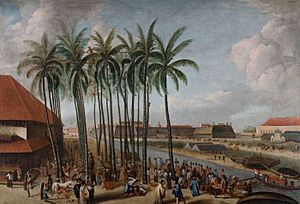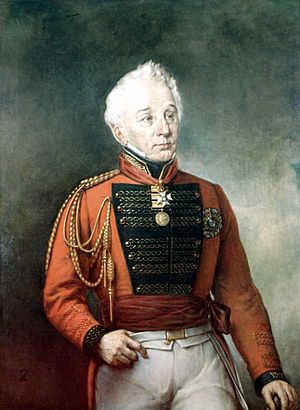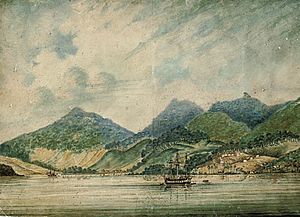59th (2nd Nottinghamshire) Regiment of Foot facts for kids
Quick facts for kids 59th (2nd Nottinghamshire) Regiment of Foot |
|
|---|---|
| Active | 1755–1881 |
| Country | |
| Branch | |
| Size | One battalion (two battalions 1804–1816) |
| Garrison/HQ | Burnley Barracks, Lancashire |
| Nickname(s) | The Lily Whites |
| Colors | White facings |
| Engagements | Napoleonic Wars Second Opium War Second Anglo-Afghan War |
The 59th (2nd Nottinghamshire) Regiment of Foot was a group of soldiers in the British Army. They were an infantry regiment, meaning they fought on foot. This regiment was created in 1755 because there was a risk of another war with France. Later, in 1881, it joined with another regiment, the 30th (Cambridgeshire) Regiment of Foot, to form the East Lancashire Regiment. This happened because of big changes in the army called the Childers Reforms.
Contents
The Regiment's Story: A Journey Through Time
How the Regiment Began
The 59th Regiment started in 1755. It was first called the 61st Regiment of Foot. Sir Charles Montagu formed it in the areas of Leicestershire and Northamptonshire. They were created to fight in the Seven Years' War. In 1756, their number changed to the 59th Regiment of Foot. This happened after two other regiments were closed down.
Soon after, the regiment moved from England to Ireland. They stayed there until 1763, doing "garrison duty." This means they were stationed in a place to protect it. In 1763, the 59th Foot sailed to Nova Scotia in North America. They stayed there until 1772. Then, they moved to Boston, Massachusetts.
Fighting in the American Revolution
The 59th Regiment was in Boston when the American Revolution began. This was a war where the American colonies fought for their independence from Britain. The soldiers of the 59th faced many dangers and lost many men. The remaining soldiers returned to England in 1776 to rebuild their numbers.
Later, in 1782, the 59th was sent to Gibraltar. This was during the end of a war between Britain and Spain. They stayed there for ten years. In 1782, many regiments were given a county name. The 59th became the 59th (2nd Nottinghamshire) Regiment of Foot. This was because the 45th Foot was already the "1st Nottinghamshire."
Wars with Revolutionary France
When war started with France in 1794, the 59th Regiment went to Flanders. This area is now part of Belgium and the Netherlands. The British and their allies faced a big defeat there. The regiment had to return to England in 1795.
Later in 1795, the 59th Foot sailed to the West Indies. They stayed there for seven years. They were stationed on the island of Saint Vincent. There, they helped stop uprisings by the Maroons, who were groups of escaped slaves. The regiment returned to England in 1802.
Adventures in the Napoleonic Wars

In August 1804, a second group of soldiers, called a "battalion," was added to the 59th Foot. The 1st Battalion sailed to the Cape of Good Hope in South Africa. The 2nd Battalion stayed in England, Ireland, and the Channel Islands until 1808.
The Cape of Good Hope had been captured by the British in 1795. But it was given back to the Dutch in 1802. On January 7, 1806, the 1st Battalion of the 59th helped land at the Cape. Within two days, the Dutch forces gave up. The regiment had only a few injuries, but this was their first "battle honour." A battle honour is a special award for bravery in a fight.
Meanwhile, the 2nd Battalion went to Spain in 1808. On January 16, 1809, they fought in the Battle of Corunna. The British won this battle, which allowed their soldiers to leave Spain safely. From England, the battalion was sent to the Netherlands in July 1809. They took part in the Walcheren Campaign, which was not successful. The unit then stayed in England and Ireland until 1812.
From the Cape, the 1st Battalion sailed to India. In November 1810, they helped invade Mauritius. The next year, they invaded Java in the Dutch East Indies. They stayed in Java until 1815, then returned to India.
In 1812, the 2nd Battalion went back to Spain. They fought in many important battles. These included the Battle of Vittoria (June 1813) and the Siege of San Sebastián (July–August 1813). They also fought in the Battle of the Bidassoa (October 1813), the Battle of Nivelle (November 1813), and the Battle of the Nive (December 1813).
After fighting in France, the 2nd Battalion (2/59th) sailed to Ireland. When Napoleon returned to France, starting the "Hundred Days" period, the battalion went to Belgium. They were in the area of the Battle of Waterloo, but they did not fight in the main battle. After being part of the army that stayed in France, the 2nd Battalion returned to England in 1816. There, they were officially closed down.
The Victorian Era: New Challenges
After the 2nd Battalion was closed, the 1st Battalion was simply called the 59th (2nd Nottinghamshire) Regiment of Foot. In 1817, the unit moved from India to Ceylon. They returned to India the next year. There, they fought in the Third Anglo-Maratha War. From 1825 to 1826, they helped capture the fortress of Bharatpur. This earned them the honour "Bhurtpore." The regiment returned to England in 1829.
For the next twenty years, the 59th did garrison duties. They were stationed in England, Ireland, Malta, and the West Indies. In 1849, they sailed to China. They were part of a small force making sure China followed the rules after the First Opium War. In 1856, Britain believed China had broken the rules, and the Second Opium War began. In January 1858, the 59th Foot, along with other British forces, took over the city of Canton.
In 1858, the 59th Foot moved to South Africa. They then returned to the United Kingdom in 1861. From 1867 to 1878, the regiment served again in India and Ceylon. From India, the 59th went into Afghanistan in November 1878. They were part of an invasion force trying to stop Russian influence in the area. In April 1880, they fought in the Battle of Ahmed Khel. Later in 1880, the 59th Foot returned to England.
Joining Forces: The Amalgamation
In the 1870s, there were changes in the army called the Cardwell Reforms. These reforms linked regiments together to share training areas. The 59th was linked with the 30th (Cambridgeshire) Regiment of Foot. They were assigned to a base at Burnley Barracks in Lancashire. On July 1, 1881, more changes called the Childers Reforms happened. The 59th Regiment joined with the 30th Regiment to form the East Lancashire Regiment. The 59th Foot became the 2nd Battalion of this new regiment. Today, the history of the 59th is carried on by the Duke of Lancaster's Regiment.
Special Awards: Battle Honours
The 59th Foot earned many special awards called "battle honours." These honours were displayed on the regiment's flags. They show where the regiment fought bravely.
|
|
A Hero's Medal: The Victoria Cross
A very special medal, the Victoria Cross, was given to Captain Euston Henry Sartorius. He received it on October 24, 1879, for his bravery during the Second Anglo-Afghan War.
|




